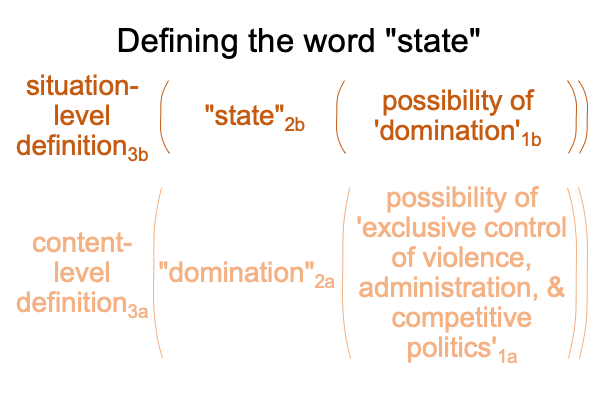Looking at David Graeber and David Wengrow’s Chapter (2021) “Why The State Has No Origin” (Part 2 of 13)
0184 Chapter ten is the only chapter on theory in the entire book. The rest of the book concerns the inadequacy of current theory in archaeology and anthropology. The authors intuitively zero in on a problem. Neither science imagines that people have minds of their own. For example, modern histories do not admit that the so-called “Western Enlightenment” is influenced by reports coming from the Americas, including an indigenous critique of late-medieval and early-modern European civilization.
However, Graeber and Wengrow cannot pass into their promised land, because they have no models for appreciating or diagramming what is going on in people’s minds.
0185 Ferdinand de Saussure (1857-1913 U0′) has a model for speech-alone talk. Spoken language contains of two arbitrarily related systems of differences, consisting of parole (speech acts) and langue (mental acts). A model of langueshould provide a picture of what is going on in people’s minds. So, how can we model langue?
One answer is provided in Razie Mah’s first masterwork, The Human Niche, plus its companion work, Comments on Robert Berwick and Noam Chomsky’s Book (2016) Why Only Us?. These are available at smashwords and other e-book venues. Langue may be modeled by diagrams of triadic relations.
In the ongoing commentary, two triadic relations are presented: the category-based nested form and judgment. If talk (parole) is related to a triadic relation (langue) then Saussure’s definition of language is satisfied. Plus, our innate sensibility that words are associated to the things that they refer to is satisfied.
0186 Our innate sensibility that words refer to things and states of things arises in the milieu of hand talk. Here, the relation between parole and langue is not arbitrary, because langue (mentally) reproduces the icons and indexes of parole(well-executed manual-brachial gestures). This is the nature of natural signs.
Curiously, the word, “semiotics”, does not appear at all in Graeber and Wengrow’s weighty volume. Yet, the term is crucial to their claim that people have minds of their own. People have minds of their own because they are adapted to sign-processing.
0187 Fast forward through human evolution to the first singularity, dramatically portrayed in Razie Mah’s second masterwork, An Archaeology of the Fall. The first singularity consists in a cultural change. Hand-speech talking cultureslose the hand-component of their hand-speech talk, leaving them with speech-alone talk. The Ubaid of southern Mesopotamia is the first culture to practice speech-alone talk. The Sumerian language is a speech-alone creole, originating from two hand-speech languages. Speech-alone talk spreads from the Ubaid to the far corners of the world.
0188 The first singularity is a complex transition. There is great uncertainty about how it happens.
But, we can set down two markers with great certainty.
Before the Ubaid, in the Lebenswelt that we evolved in, all cultures practice hand-speech talk.
In the present, 2023 U0′, in our current Lebenswelt, all civilizations practice speech-alone talk.
0189 Speech-alone talk does not picture or point to its referents. Instead, speech-alone talk projects meaning, presence and message into a purely symbolic label. This label belongs to parole. Parole consists of a system of differences. Langue is arbitrarily related to parole.
So, if we are to display… or imagine… or depict what people think, we may be begin with the proposition that those thoughts have the structure of triadic relations, such as the category-based nested form.
This is the proposition underlying Razie Mah’s third masterwork, How To Define the Word “Religion”. The propositionconcerns the nature of definition. The category-based diagram offers ways to picture the meaning, presence and message underlying the spoken word, “religion”.
0190 Here is a picture.

The normal context of definition3 brings the actuality of a spoken word2 into relation with the possibilities inherent in meaning, presence and message1.
0191 Such a diagram offers sites for explicit abstraction, without short-changing implicit abstraction. Standard dictionaries define spoken words with combinations of other spoken words, emphasizing the idea that words are placeholders in systems of differences (that is, “languages”). It does not evoke the idea that a spoken word (parole) is arbitrarily related to what people think (langue). In contrast, the category-based nested form for how to define a spoken word conveys what standard dictionaries cannot tell.














